Rotorua
Waimangu
Thermal Valley
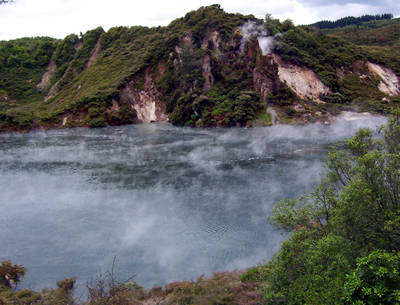
ROTORUA
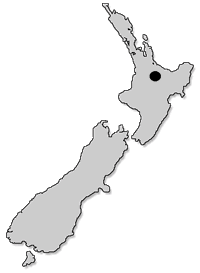
|
Pictures
of Waimangu Volcanic Valley
Rotorua
Highlights
Adventure in Rotorua
Photos
of Rotorua
Adventure Photos of Rotorua
Sightseeing,
Tours, Attractions and Events in Rotorua
Hotels
and Accommodation in Rotorua
By
Richard Moore
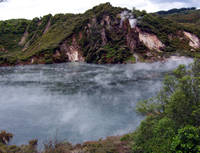 People
who like eco-touring, or seeing Nature at its most primeval, may
want to make a note of the Waimangu
Volcanic Valley. People
who like eco-touring, or seeing Nature at its most primeval, may
want to make a note of the Waimangu
Volcanic Valley.
It
is a geothermal area in New Zealand, just south of Rotorua in the North Island, and was formed only 118 years ago by a massive
volcanic eruption that destroyed a mountain called Tarawera.
The
exploding Mt Tarawera smothered a nearby settlement, Te
Wairoa, now known as The
Buried Village and formed the volcanic valley at Waimangu.
There
are seven thermal craters within the valley that is something out
of the age of dinosaurs.
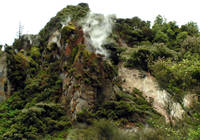 Fern-covered
hills are dotted with steaming fissures, the waters of the small
lakes are shrouded in hot mists and a hot-water stream bubbles through
pristine bushland. Fern-covered
hills are dotted with steaming fissures, the waters of the small
lakes are shrouded in hot mists and a hot-water stream bubbles through
pristine bushland.
It doesn't take much imagination to look at the scenery and picture
a tyrannosaur or spinosaurus lurking somewhere within the treeline
just waiting for you to venture too close.
Walking
along the paths at Waimangu is a very peaceful thing to do with
plenty of native wildlife and flora to look at along the way.
The
visitors' centre will arm you with a map and that gives you more
than 30 things to stop and look at in the valley.
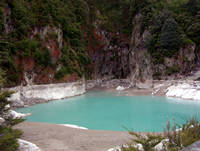 There
are three walks you can take, all interconnected, and they run from
one hour (1.5 kilometres) to two hours (3.6 kilometres). They
take you past the Southern Crater, a 50-metre deep water-filled
crater that was born during the 1886 eruption, Echo Crater and the
world's largest hot spring Frying
Pan Lake. There
are three walks you can take, all interconnected, and they run from
one hour (1.5 kilometres) to two hours (3.6 kilometres). They
take you past the Southern Crater, a 50-metre deep water-filled
crater that was born during the 1886 eruption, Echo Crater and the
world's largest hot spring Frying
Pan Lake.
Echo
Crater is an audiophile's dream come true with lots of weird and
wonderful sounds using from the springs and vents in the vicinity.
The
55-degree Celcius water in Frying Pan Lake is acidic and covers
38,000 square metres - sort of like a hot bath and skin remover
all in one.
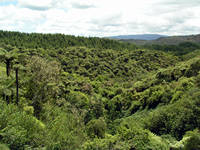 Not
far from those attractions is arguably the highlight of a visit
to Waimangu - the stunning coloured waters of Inferno
Crater. Not
far from those attractions is arguably the highlight of a visit
to Waimangu - the stunning coloured waters of Inferno
Crater.
You
need to take a steep-stepped detour from the main track (it says
two minutes but it is less than half of that) and the sight is worth
any amount of huffing and puffing.
The
water of Inferno Crater is an amazing turquoise hue and, considering it was created when
the eruption blew a hole in the side of Mt Hazard, it is incredibly
peaceful.
This
belies what is going on under the surface of the water because Inferno
Crater is actually the world's largest geyser-like phenomenon although
its geothermal activity is hidden some 30 metres down.
Bus
Stop No.1 is only a few minutes walk further on and that can take
you back to the visitors' centre if you are pressed for time.
Just
ahead is an interesting placed marked as Buried Soil and this cliff
area clearly shows the black band of soil marking the erupting Mt
Tarawera and a 2000-year-old pumice layer underneath it.
Waimangu
also boasts some beautiful silica terraces and stalactites and hot
springs that allow unusual lichens and mosses to grow.
The
end of the walk is at a picnic area on the shores of Lake Rotomahana
and there is a 45-minute cruise available for those wanting to get
a water-side view of this volcanic area. A note there is no toilet
on board the vessel.
Then
it is take the bus back to the visitors' centre for a pie and soft
drink, or coffee, and look out over a valley containing some truly
beautiful scenery. |